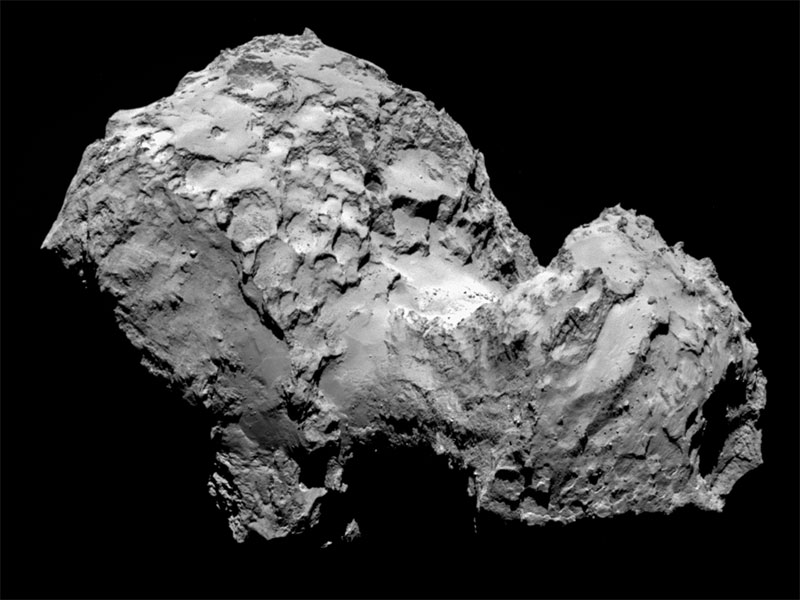
New: Early Mornings! Join us on Thursdays and Fridays in April, starting at 9 a.m.

By David Harker, Associate Research Scientist, UCSD Center for Astrophysics and Space Sciences (CASS)
The primary mission of Rosetta's visit to comet 67P/Churymov–Gerasimenko is to further our understanding of the origin and evolution of our solar system. Comets can be thought of as time capsules since they formed within 100,000 years of the formation of the solar nebula, which is thought to be tens of millions of years older than the formation of the solar system 4.7 billion years ago.
Comets are a direct link to the conditions and processes in the early solar nebula. It’s these conditions and processes that eventually led to the formation of planets, including Earth.
The other benefit of analyzing comets is they have also not changed much chemically since their formation. When we look at the molecules and dust grains from comets, we look into the past of our solar system.
Rosetta will certainly address many science questions about comets and what they can tell us, but these are five science questions that I am interested in as a comet observer:
1) What is the composition of the comet 67P nucleus?
The solid, core structure of a comet is known as the nucleus. Comets nucleuses are a collection of dust, rock and ices, commonly referred to as “dirty snowballs.” As the comet approaches the Sun, the ice begins to sublimate and turn into a gas. These gasses are referred to as "volatiles." As the gas escapes from the nucleus of the comet, dust grains are also entrained within the gas and are expelled into space. These dust grains create what is called a “coma” around the nucleus, giving the comet its fuzzy look. Until now, astronomers have only been able to observe the material expelled from comets through telescopes. Now with Philae on the surface of comet 67P, we hope it has taken samples of the nucleus itself and can tell us more about the composition of comet 67P.
2) How does the activity of the nucleus change as the comet approaches the Sun?
It is well known that as comets approach the Sun, the volatile ice particles within the nucleus begin to sublimate, ejecting dust grains and forming the fuzzy coma. How strongly the dust grains are coupled with the gas is not well known. As comet 67P approaches the Sun, Rosetta will monitor the increase in output from the comet to measure the interplay of gas and dust.
3) Do comets have a hard crust surface?
The tensile strength of a comet is not completely understood. In 2005, the Deep Impact probe released an impactor that collided with comet 9P/Tempel 1, making a crater about 100 feet deep. Although not insignificant, the size and depth of the crater was small enough to rule out the scenario of comet 9P having a porous, fluffy nucleus. Another theory is that the surface of comets are "crusted over" with ice and other hard material. If this is true, then the crust may stifle or prevent the release of gas and dust as the comet approaches the sun. A tentative result from Philae shows that the surface of 67P is hard ice covered with dust. This seemingly confirms the existence of a hard crust on the nucleus of 67P. Hopefully more data can verify this result in the future.
4) Did comets deposit some of the water that helped create our present-day oceans?
We know that the Earth has water, but where did it all come from? One idea is that during the Late Heavy Bombardment period, an untold number of comets impacted Earth, depositing water on the surface. This would have occurred 3.8 to 4.1 billion years ago, when the giant outer planets—Jupiter, Saturn and Neptune—perturbed the orbits of a large amount of comets, sending them toward the Sun and the inner rocky planets. The heavy barrage of comets hitting the Earth during this period could have deposited a significant amount of water.
The way that Rosetta is going to explore the question of comet water deposition is to look at the isotopic composition of comet 67P, specifically an isotope of hydrogen called deuterium. Deuterium is a stable isotope of hydrogen that contains one proton, one neutron and one electron. Hydrogen, by contrast, is just a single proton and a single electron. If the ratio of hydrogen to deuterium in the water of Earth's oceans is similar to the ratio of the ice in comets, it would imply that ice from comets could in fact be a contributor to the Earth's oceans.
5) Did life on Earth start with help from comet seeding?
If comets were depositing water on the Earth during the Late Heavy Bombardment period, could they also have deposited more complex molecules such as amino acids, thereby planting the first seeds of life? While we know that comets contain simple organic molecules, nothing as complex as a protein or amino acid has ever been detected. The instruments on Philae are equipped to determine the composition of organics from comet 67P. These findings could lead to the most incredible scientific contributions of the whole mission!